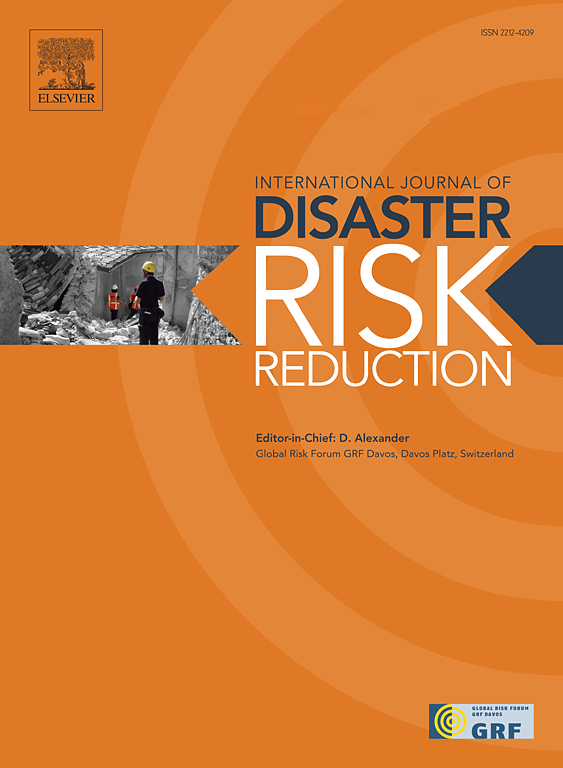通过多维指数的比较分析,加强对山洪脆弱性和复原力的认识
IF 4.2
1区 地球科学
Q1 GEOSCIENCES, MULTIDISCIPLINARY
International journal of disaster risk reduction
Pub Date : 2025-05-01
DOI:10.1016/j.ijdrr.2025.105540
引用次数: 0
摘要
本研究考察了西班牙卡斯蒂利亚León地区山洪暴发风险的脆弱性和复原力之间的关系。它比较了脆弱性和恢复力指数,并检查了它们与山洪风险相关变量的关系。它还讨论了通过多维方法改进评估,包括社会、经济、生态系统、物理、制度和文化维度。我们的方法使用统计和空间技术,包括斯皮尔曼相关性、双变量剖面图和回归模型。结果表明,脆弱性和恢复力是两个相关但不同的概念。各指标间相关性较弱(r = 0.06),但各要素间相关性显著。例如,弹性指数与脆弱性的暴露分量显著相关(r = 0.40)。空间回归表明,恢复力指数与脆弱性维度局部R2值为0.74。一些脆弱性因素也与与山洪风险有关的某些变量显著相关。这些因素主要是暴露因素(对于处于风险中的人口,r = 0.59)和制度因素(对于保险公司提供的洪水赔偿总额,r = - 0.48)。在局部R2为0.85的情况下,脆弱性和恢复力指数随关键基础设施的风险呈现显著的空间回归。这些结果突出表明,需要改进对复原力和脆弱性的评估,特别是适应当地情况的评估。这强调了需要一种多维方法,将理论框架与实际应用相结合,以指导未来的研究计划并为决策者提供信息。本文章由计算机程序翻译,如有差异,请以英文原文为准。
Enhancing understanding of vulnerability and resilience to flash floods through comparative analysis of multidimensional indices
This study examines the relationship between vulnerability and resilience concerning flash flood risk in Castilla y León, Spain. It compares vulnerability and resilience indices and examines their relationships with variables related to flash flood risk. It also discusses improving assessments through a multidimensional approach, which includes social, economic, ecosystemic, physical, institutional, and cultural dimensions. Our approach uses statistical and spatial techniques, including Spearman correlations, bivariate choropleth maps, and regression models. Results show that vulnerability and resilience are related but distinct concepts. The correlation between their indices is weak (r = 0.06), but there are significant correlations between specific elements. For instance, the resilience index and the exposure component of the vulnerability correlate significantly (r = 0.40). Spatial regressions show a local R2 value of 0.74 between the resilience index and vulnerability dimensions. Some elements of vulnerability are also significantly correlated to certain variables related to flash flood risk. These are mostly the exposure component (r = 0.59 for the population at risk) and the institutional dimension (r = −0.48 for the total flood indemnities provided by the insurance company). With a local R2 of 0.85, the vulnerability and resilience indices show significant spatial regression with the critical infrastructure at risk. These results highlight the need for improved assessments of resilience and vulnerability especially adapted for local contexts. This emphasizes the need of a multidimensional approach combining theoretical frameworks with practical applications to guide future research initiatives and inform policymakers.
求助全文
通过发布文献求助,成功后即可免费获取论文全文。
去求助
来源期刊

International journal of disaster risk reduction
GEOSCIENCES, MULTIDISCIPLINARYMETEOROLOGY-METEOROLOGY & ATMOSPHERIC SCIENCES
CiteScore
8.70
自引率
18.00%
发文量
688
审稿时长
79 days
期刊介绍:
The International Journal of Disaster Risk Reduction (IJDRR) is the journal for researchers, policymakers and practitioners across diverse disciplines: earth sciences and their implications; environmental sciences; engineering; urban studies; geography; and the social sciences. IJDRR publishes fundamental and applied research, critical reviews, policy papers and case studies with a particular focus on multi-disciplinary research that aims to reduce the impact of natural, technological, social and intentional disasters. IJDRR stimulates exchange of ideas and knowledge transfer on disaster research, mitigation, adaptation, prevention and risk reduction at all geographical scales: local, national and international.
Key topics:-
-multifaceted disaster and cascading disasters
-the development of disaster risk reduction strategies and techniques
-discussion and development of effective warning and educational systems for risk management at all levels
-disasters associated with climate change
-vulnerability analysis and vulnerability trends
-emerging risks
-resilience against disasters.
The journal particularly encourages papers that approach risk from a multi-disciplinary perspective.
 求助内容:
求助内容: 应助结果提醒方式:
应助结果提醒方式:


